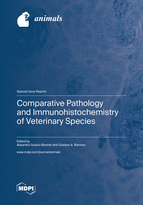Comparative Pathology and Immunohistochemistry of Veterinary Species
A special issue of Animals (ISSN 2076-2615). This special issue belongs to the section "Veterinary Clinical Studies".
Deadline for manuscript submissions: closed (14 May 2021) | Viewed by 34710
Special Issue Editors
Interests: anatomic, comparative, and diagnostic pathology; dermatopathology; ocular pathology; domestic and laboratory animals; exotic, zoo and wildlife pathology
Special Issues, Collections and Topics in MDPI journals
Interests: anatomic, comparative and diagnostic pathology; oncopathology; dermatopathology; domestic and exotic pathology; zoo and wildlife pathology
Special Issues, Collections and Topics in MDPI journals
Special Issue Information
Dear Colleagues,
Comparative pathology, translational research, and clinical trials involving companion animals have the ultimate goal of advancing our medical knowledge of both human and veterinary species. Furthermore, comparative pathology plays a fundamental role in the One-Health concept. The National Cancer Institute have long recognized the potential of naturally occurring tumors in veterinary species to advance the study of human cancer, and for that reason the Comparative Oncology Program (COP) was established more than a decade ago. Furthermore, companion, laboratory (from mouse to non-human primates), and wildlife animals play a pivotal role in our understanding of infectious diseases—particularly those with a zoonotic component.
Immunohistochemistry is a routine diagnostic technique that is often essential to reach a final diagnosis. It is almost always part of any anatomic pathology study in cancer, infectious, or developmental diseases.
In this Special Issue of the prestigious journal Animals (a Q1 veterinary sciences journal), we aim to gather high-quality papers addressing different areas of pathology, with a special focus on comparative aspects with the human species. Researchers working in veterinary pathology, veterinary microbiology and infectious diseases, and veterinary parasitology are welcome to contribute in-depth reviews, original full articles, and unique case reports. The use of immunohistochemical techniques will be of particular interest.
Dr. Alejandro Suárez-Bonnet
Dr. Gustavo A. Ramírez
Guest Editors
Manuscript Submission Information
Manuscripts should be submitted online at www.mdpi.com by registering and logging in to this website. Once you are registered, click here to go to the submission form. Manuscripts can be submitted until the deadline. All submissions that pass pre-check are peer-reviewed. Accepted papers will be published continuously in the journal (as soon as accepted) and will be listed together on the special issue website. Research articles, review articles as well as short communications are invited. For planned papers, a title and short abstract (about 100 words) can be sent to the Editorial Office for announcement on this website.
Submitted manuscripts should not have been published previously, nor be under consideration for publication elsewhere (except conference proceedings papers). All manuscripts are thoroughly refereed through a single-blind peer-review process. A guide for authors and other relevant information for submission of manuscripts is available on the Instructions for Authors page. Animals is an international peer-reviewed open access semimonthly journal published by MDPI.
Please visit the Instructions for Authors page before submitting a manuscript. The Article Processing Charge (APC) for publication in this open access journal is 2400 CHF (Swiss Francs). Submitted papers should be well formatted and use good English. Authors may use MDPI's English editing service prior to publication or during author revisions.
Keywords
- domestic animals
- immunohistochemistry
- laboratory animals
- oncology
- veterinary pathology
- veterinary microbiology and infectious diseases
- veterinary parasitology
- zoo and wildlife pathology
- zoonosis








